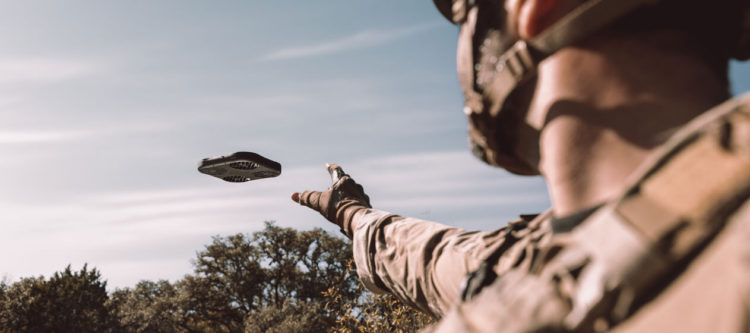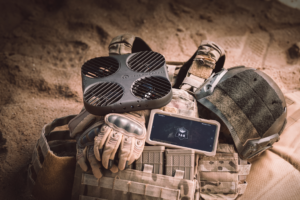Tech Spotlight Series: Darkhive’s lower-cost drones give situational awareness while keeping people safe

The chase is on, a law enforcement officer racing after a dangerous fugitive through the dark and winding streets. With every passing moment, the tension mounts, the stakes higher as they get further away from backup. Suddenly, the fugitive darts into an abandoned building, slamming the door shut behind them. The officer knows that they could be walking into a trap. The fugitive might be armed, and might be waiting to pounce at any moment.
With a steady hand, the officer reaches into her pocket and pulls out a small, sleek drone. She tosses it into the air, and it zooms into the building through a broken window, scanning every inch of the space. The officer waits, her heart pounding in her chest, as the drone relays back vital information. Is the fugitive still inside? Are they barricaded and ready to attack?
The drone whizzes back out of the building and into the officer’s waiting hand. She pockets it hastily, her mind racing with her next steps. Thanks to Darkhive’s drone technology, she has all the information she needs to make a decision that could mean the difference between life and death. Situational awareness is key in moments like these, and Darkhive’s solutions make it possible for law enforcement and defense personnel to stay one step ahead of the game.
Darkhive is building lower-cost autonomous drones for public safety and military personnel designed to be scalable in cost, deployment, and management. Even better, these durable drones can perform in austere environments and include sensors to assist in low-vision missions. Darkhive’s YELLOWJACKET drone is also compact enough to fit in a pocket and is easy to use.
The Last Mile recently sat down with Steve Turner, Chief Technology Officer of Darkhive, to learn more about how their YELLOWJACKET drone aims to help keep law enforcement and military personnel safe while giving immediate situational awareness in challenging environments.
 The Last Mile (TLM): Can you tell our readers a bit about Darkhive? What does the organization do? What kinds of solutions does it offer, and who does it offer them to?
The Last Mile (TLM): Can you tell our readers a bit about Darkhive? What does the organization do? What kinds of solutions does it offer, and who does it offer them to?
Steve Turner: Our CEO, John Goodson, and I worked together for about five years prior to starting Darkhive, which is a little over a year old now. We’re building lower-cost drones than other domestic manufacturers on the market that serve public safety and defense users.
John likes to joke that he hates drones since both of us have a lot of negative experiences with them. In John’s case, as a prior Navy combat technician supporting both West and East Coast SEAL teams, he had situations where drones failed him or created additional risks to recovering them.
That’s a typical story with many platforms where the drone is expensive or has sensitive software inside of it, so when a user loses it, they have to go to recover it. More costly drones are just not reliable enough for the cost. Many times these more expensive drones go unused because people fear they will lose them or fear the real dangers it creates to recover the drones.
I have worked in safety technology for almost 15 years, mostly incorporating electronic warfare equipment into user interfaces and larger networks. For me, on the engineering side, often integrating things with drones as a software engineer and putting payloads or sensors on them, it was frustrating dealing with some of the companies in this space. That’s why we started Darkhive; to eliminate the challenges that John and I encountered.
John and I also took a look at the cost of these platforms and what users are requesting. Even on the defense side, users would say they are not using American-made drones because they are so expensive, and they are worried about losing them. And even when an American-made drone is purchased, it just sits on the shelf. Some users are buying their own Chinese-made drones and flying them because it’s not a big deal when it crashes. This motivated us at Darkhive to create something that was accessible while meeting some of these tactical needs for public safety, law enforcement, and defense.
TLM: What is an autonomous drone? How is that different from other drones in the marketplace?
Steve Turner: There are a couple of different levels of autonomy. A good comparison is what’s happening in autonomous vehicles or cars that drive themselves. It’s the difference between manually driving the drone or telling it what you want it to do without crashing into trees or people. Our drones use cameras and computer vision to navigate around obstacles and solve simple tasks.
If you can imagine a police officer, instead of them staring at a video screen and having their hands on a remote control, they can complete other tasks they need to accomplish, such as kicking in a door or serving a warrant. The Darkhive drone can provide safety and identify threats without law enforcement having to watch the video from the drone all the time. It’s trying to take the person out of control as much as possible, but to do that, we have to build trust that the drone can fly itself reliably and relay critical information rapidly.

TLM: According to your website, Darkhive’s YELLOWJACKET drones are, “designed to be scalable in cost, deployment, and management.” What does that mean? And what does that mean for public safety and military personnel?
Steve Turner: On the cost side, if you think about local law enforcement, they’re looking at their budget to make the decision between a police cruiser and a drone. If those items are roughly the same cost, they’re going to go with the police cruiser every single time because of the relative value. We want the drones to be affordable enough that a user can get ten of them instead of getting one platform to scan a facility or provide surveillance. We’re trying to get closer to current commercial costs so that they’re more available, and if one is lost, it’s not a big deal; another one can be purchased.
On the deployment side, a lot of these pieces of hardware and other drones are used in high-pressure dynamic environments. Users don’t have time to pull something out of a crate, unfold it, calibrate it, and get it out in the air – users need the drone to be like a boomerang. So we’re trying to make it as easy as possible to get drones in play and provide intelligence to our user communities.
Related to cost and deployment, our drones are disposable. We believe, for the YELLOWJACKET in particular, that everyone should have one. User communities need to enable as many people to carry these drones, so if they’re in a situation where they need a drone, It’s available. It’s just like having a cell phone or another key piece of equipment users might carry but without too much added cognitive and physical burden.
Part of that, too, is the design of the platforms we’re building. It’s popular or common now for “drone-in-a-box” solutions where a drone takes off from a landing pad, so we are designing our drones to be compatible with a system like that. Not with just one drone, but users can have many drones in a single box deploying automatically.
Many drones on the market right now have a closed software ecosystem. We want to open up software systems for third-party developers to make it easier for fleets of drones to be controlled and also validate the software supply chain of the products that we’re providing to the military and government.
There’s a program from the U.S. Defense Innovation Unit called the Blue UAS framework, and they’ve done a great job validating hardware and cybersecurity. We’re really looking to build on that to validate software that’s getting deployed from cybersecurity requirements all the way to simulating and validating the behavior and then ultimately deploying it in the field. In summary, we’re trying to simplify our hardware’s management lifecycle.
TLM: For what different missions and use cases could you envision law enforcement and military users needing the YELLOWJACKET drone? What unique capabilities, functionality, and attributes does the YELLOWJACKET bring to the table that make it ideal for these missions?
Steve Turner: The YELLOWJACKET drone is designed for immediate vicinity awareness, so it’s not something that goes out on long missions and flies for hours. It’s the kind of drone that is like a boomerang; a user tosses the drone into the air, and it goes out to take a quick look at something over the closest ridge line or roof. Or maybe it goes into the first room of a building, gives me a quick 360 overview, and then comes back.
The YELLOWJACKET drone also has a durable physical design where a user can throw it into a pocket. A user can bang it around a little bit, and it’s not going to affect its flight performance. The rotors are actually enclosed as well, so a user can grab it out of the air and not worry about getting their fingers caught in the props. Even while piloting the drone, the user is not going to injure surrounding people if an accident occurs. The YELLOWJACKET drone has a number of sensors on it, including a thermal camera for nighttime and low-vision operations and a couple of other cameras for navigation. This drone is designed for someone to receive immediate awareness under high pressure.
In the last few years, there have been some high-profile national events where a high-risk warrant is being served. Imagine an officer is serving this warrant and about to enter an unknown building. They are breaching the door and don’t know what’s on the other side. The officer is about to send their point man in, and somebody with a weapon could be on the other side. There could be someone that looks threatening, and the officer accidentally injures them.
The YELLOWJACKET drone is a way to take away that entry risk by flying the drone to get a quick 360 scan of the room. In the kind of environment where things are moving quickly, the user is likely armed, so it’s a very risky situation for all parties involved. The user in this scenario can throw the YELLOWJACKET in the room to get a quick look. Once the user is in the room, they can either proceed to fly it into further areas or snatch it out of the air to stow it, waiting until they need to use it again when clearing the rest of the facility.
TLM: Darkhive is pursuing being a goTenna partner. How do the company’s YELLOWJACKET drones integrate with or utilize mobile mesh networking? What capabilities or functionality do goTenna’s mobile mesh networking technologies bring to the table?
Steve Turner: What we like about goTenna’s product is its ease of use. They’re low-cost compared to other radios on the market and are designed for the same communities that we intend to support. A user needs to get critical information relayed to their team without relying on cell service or Wi-Fi. Users don’t necessarily need to stream high-definition video; they just need to know where their team is and tell them where to go.
That fits well with what we’re doing with the YELLOWJACKET, where a user just needs our drone to tell them when it sees someone that’s armed or sees a vehicle and then follows it. The goTenna radios are perfect for that because they’re lower cost than many options on the market. goTenna devices are easy to integrate with, and they’re much smaller than a lot of other solutions.

TLM: How does the use of Darkhive solutions in conjunction with goTenna mobile mesh networking benefit military and law enforcement users? What does it enable for them?
Steve Turner: The biggest thing is situational awareness that’s already integrated with goTenna’s current tools at a cost that doesn’t break the bank. Many of the communities we support at Darkhive use, for example, the government open platform, Android Team Awareness Kit (ATAK), and goTenna’s solutions are integrated with that platform.
It’s a natural partnership where ideally, our drones fit into that same kit. Users can pull up their existing Android devices that they use with goTenna radios, and it’s as simple as making a phone call to get the devices paired up and working. That’s really what we’re aiming for is ease of use, and it is something the goTenna radios definitely have changed on the market with public safety and defense.
TLM: Why has Darkhive chosen to pursue partnering with goTenna? What about goTenna’s solution and the company itself made you decide to become a partner?
Steve Turner: A number of years ago, I personally saw some goTenna radios at an evaluation event, and I was really impressed with the size and cost. It blew me away how easy it was to relay data using mobile devices in the middle of nowhere. The goTenna radios were basically doing the same thing at a fraction of the cost of much more expensive radios that cost $20,000 to $30,000. I was also blown away by how simple and easy it was to use the goTenna devices and how people took to them quickly.
Based on that experience, I could see it was easy to integrate with the radios, and the team is easy to work with. And finally, the goTenna team supports other small businesses by providing resources and then partnering with them to build solutions for public safety and defense. So this is a good partnership that we have to mature and grow over the years.
To learn more about Darkhive and receive the latest product updates, visit their website, Twitter, and LinkedIn pages. To see how goTenna works during a law enforcement scenario, watch a virtual demo here.
Disclaimer: Please note, for all aerial assets, be sure to follow any applicable government regulations and restrictions during your deployment.







No Comment